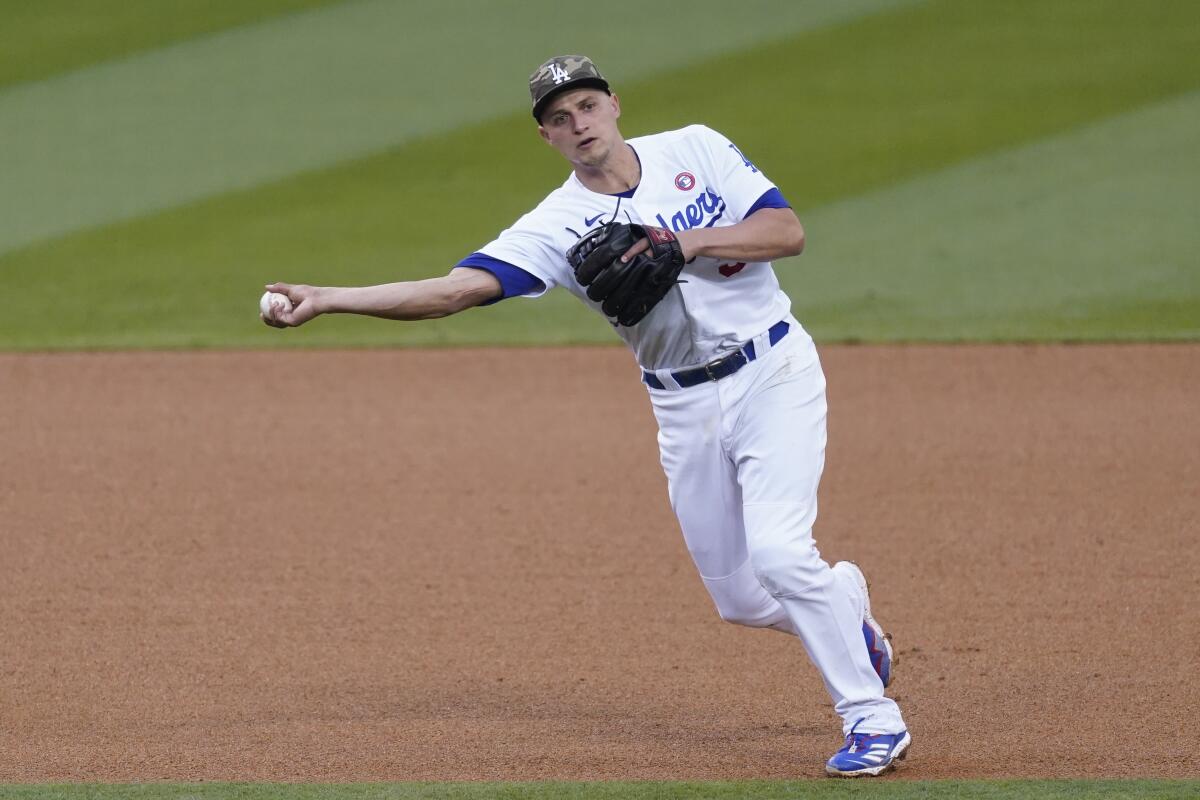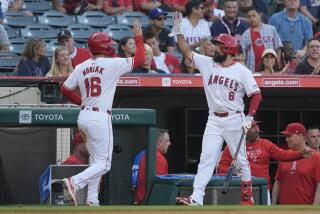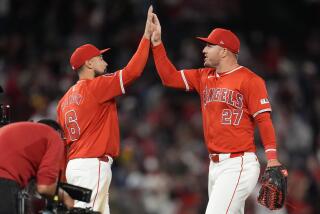Angels’ future: promising young arms and Corey Seager at shortstop?

- Share via
This was a good weekend for the Dodgers. They beat the Angels twice, they marveled at Trea Turner scoring from first base on a single on Sunday, and they moved three days closer to their ninth consecutive postseason appearance.
This was a good weekend for the Angels too. They lost the Freeway Series, but they got encouraging performances from the young arms needed to get them back to the postseason for the first time since 2014, and they got a look at the bat they could use to fortify a potent offense come 2022.
Turner should be the Dodgers’ shortstop next season. Corey Seager should be the Angels’ shortstop.
Turner’s speed provides an offensive dimension rare in today’s game. The Dodgers cherish the positional flexibility he offers. Advanced metrics — including runs saved, ultimate zone rating, and outs above average — rate him as superior to Seager on defense. And, unlike Seager, Turner cannot leave as a free agent after the season.
Just when it looked like a division rival would make the biggest splash at the trade deadline, Andrew Friedman of the Dodgers came through again.
If the Dodgers let Seager go in free agency, he would be available to the Angels. Seager has not played a major league season that did not extend into October. Could the Angels convince him they can get there?
He would know the issue. You would know the issue. Angels manager Joe Maddon knows the issue.
The Angels cannot identify young starting pitchers until they audition them, and not just over the last couple weeks of another lost season. Throw them against teams like the Dodgers, sink or swim, and see who stays afloat.
“That’s what we need to know going into the offseason,” Maddon said. “That’s the foundation. Without that, we will languish in the area of .500 for a long, long time.”
In fact, the Angels stand at exactly .500 today. They could finish with their sixth consecutive losing season, for the first time since Jimmy Carter occupied the White House and KC and the Sunshine Band occupied AM radio.
The Angels drafted nothing but pitchers this year. None of the pitchers they drafted in the 2010s have thrown even 100 innings in a season for them.
So, for the last three years, they have thrown millions at middling veteran arms, just to be able to fill out a starting rotation: $20 million for Trevor Cahill and Matt Harvey in 2019, $14 million for Dylan Bundy and Julio Teheran last year, $21 million for Bundy, Alex Cobb and José Quintana this year.
That, as Maddon noted, is a recipe for .500. It is the difference between a team that aspires to compete and a team that aspires to contend.
Since the All-Star break, the Angels have let the kids pitch. And, since the All-Star break, the Angels starters have pitched more innings than the starters on any other major league team.
They have posted a 3.62 earned-run average. That ranks fifth in the American League, behind four potential playoff teams: the Chicago White Sox, New York Yankees, Oakland Athletics and Toronto Blue Jays.
You can learn a little when your pitchers can handle the Texas Rangers. You can learn a lot when your pitchers can handle the Dodgers.
“If we don’t pitch, you can’t beat teams like this,” Maddon said. “You cannot. Impossible. Ain’t gonna happen.”
On Friday, Patrick Sandoval held the Dodgers to two runs in five innings. On Saturday, Jaime Barria held the Dodgers to three runs in six innings.

On Sunday, in his second major league start, Reid Detmers showed flashes of why the Angels made him their top draft pick last year. He gave up two runs in the first inning and three in the second, but he pitched three more innings, all scoreless.
Detmers threw two quick strikes to Turner, the Dodgers’ first batter, but Turner fouled off two more pitches and doubled on the next one. He threw a marvelous 75 mph curve to the next batter, Max Muncy, who then whacked a two-strike fastball for an RBI single.
He faced eight batters in the inning but did not nibble or pitch scared, throwing 22 strikes and five balls. In the next inning, with two out and a 3-0 count, he threw a third consecutive fastball to Albert Pujols, who homered.
“I got caught up in the moment,” Detmers said, “and tried to sneak a fastball by him. He was sitting on it.”
If the Angels can cobble a rotation out of some mix of Sandoval, Barria, Detmers, José Suarez, Griffin Canning, Chris Rodriguez and Shohei Ohtani — perhaps supplemented with one veteran starter, and with the return of closer Raisel Iglesias — they can focus their financial resources on the offense.
Ohtani is the designated hitter and Max Stassi the catcher, with Mike Trout, Jo Adell, Brandon Marsh and Justin Upton manning the outfield. Jared Walsh plays first base, David Fletcher second, and Anthony Rendon third.
Albert Pujols, replacing an injured Justin Turner, hit a two-run home run in the second inning Sunday to help the Dodgers defeat the Angels.
That could leave a Seager-sized hole at shortstop, and the possibility of a power-packed lineup that could ease the pressure on young starters.
The last thing the Angels need, of course, is another enormous contract for a past-his-prime position player. But consider this: Pujols was over 30 when the Angels acquired him. So were Josh Hamilton, Zack Cozart, Gary Matthews Jr. and Vernon Wells.
Seager is 27. He plays a premium defensive position, and the World Series MVP and two-time All-Star has been above league average as a hitter every season of his career — even this one, when his power has been slow to return after a hand injury.
The Angels will finally be done with the Pujols contract this year. They should invest the savings in an impact bat, not another collection of mediocre arms. With Pujols gone in Anaheim, No. 5 is waiting for Seager.
More to Read
Go beyond the scoreboard
Get the latest on L.A.'s teams in the daily Sports Report newsletter.
You may occasionally receive promotional content from the Los Angeles Times.













